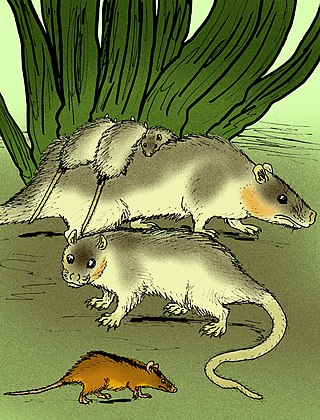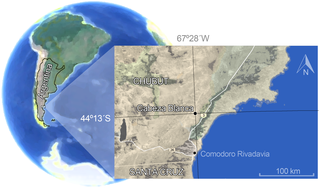
Sparassodonta is an extinct order of carnivorous metatherian mammals native to South America, related to modern marsupials. They were once considered to be true marsupials, but are now thought to be a separate side branch that split before the last common ancestor of all modern marsupials. A number of these mammalian predators closely resemble placental predators that evolved separately on other continents, and are cited frequently as examples of convergent evolution. They were first described by Florentino Ameghino, from fossils found in the Santa Cruz beds of Patagonia. Sparassodonts were present throughout South America's long period of "splendid isolation" during the Cenozoic; during this time, they shared the niches for large warm-blooded predators with the flightless terror birds. Previously, it was thought that these mammals died out in the face of competition from "more competitive" placental carnivorans during the Pliocene Great American Interchange, but more recent research has showed that sparassodonts died out long before eutherian carnivores arrived in South America. Sparassodonts have been referred to as borhyaenoids by some authors, but currently the term Borhyaenoidea refers to a restricted subgroup of sparassodonts comprising borhyaenids and their close relatives.

Thylacosmilus is an extinct genus of saber-toothed metatherian mammals that inhabited South America from the Late Miocene to Pliocene epochs. Though Thylacosmilus looks similar to the "saber-toothed cats", it was not a felid, like the well-known North American Smilodon, but a sparassodont, a group closely related to marsupials, and only superficially resembled other saber-toothed mammals due to convergent evolution. A 2005 study found that the bite forces of Thylacosmilus and Smilodon were low, which indicates the killing-techniques of saber-toothed animals differed from those of extant species. Remains of Thylacosmilus have been found primarily in Catamarca, Entre Ríos, and La Pampa Provinces in northern Argentina.

Pyrotherium is an extinct genus of South American ungulate, of the order Pyrotheria, that lived in what is now Argentina and Bolivia, during the Late Oligocene. It was named Pyrotherium because the first specimens were excavated from an ancient volcanic ash deposit. Fossils of the genus have been found in the Deseado and Sarmiento Formations of Argentina and the Salla Formation of Bolivia.

Borhyaenidae is an extinct metatherian family of low-slung, heavily built predatory mammals in the order Sparassodonta. Borhyaenids are not true marsupials, but members of a sister taxon, Sparassodonta. Like most metatherians, borhyaenids and other sparassodonts are thought to have had a pouch to carry their offspring around. Borhyaenids had strong and powerful jaws, like those of the unrelated placentalians Hyaenodon and Andrewsarchus, for crushing bones. Borhyaenids grew up to an average of 5 to 6 feet long. Borhyaena is the type genus of this group.

Anachlysictis gracilis is an extinct carnivorous mammal belonging to the group Sparassodonta, which were metatherians that inhabited South America during the Cenozoic. Anachlysictis is the first record of such borhyaenoids in northern South America, and also the most primitive known member of the family Thylacosmilidae, a group of predators equipped with "saber teeth". It was also the only confirmed record of a thylacosmilid that did not belong to the genus Thylacosmilus until the official publication of Patagosmilus in 2010.

Dukecynus is an extinct genus of meat-eating metatherian belonging to the order Sparassodonta, which lived in South America during the Middle Miocene (Laventan), between about 13.8 and 11.8 million years ago. The name of the genus meaning "Duke dog", for Duke University and the Greek word cynos, dog, for the pretended similarity of this animal with dogs. A single species known so far, Dukecynus magnus. The species name "magnus" derives from Latin for big, to reflect their great size.

Proborhyaenidae is an extinct family of metatherian mammals of the order Sparassodonta, which lived in South America from the Eocene (Mustersan) until the Oligocene (Deseadan). Sometimes it has been included as a subfamily of their relatives, the borhyaenids. The largest species, Proborhyaena gigantea, is estimated to be about the size of a spectacled bear, with its skull reaching 60 cm (2.0 ft) in length, and body mass estimates up to approximately 90–200 kg (200–440 lb), making the proborhyaenids some of the largest known metatherians. Proborhyaenid remains have been found in western Bolivia, Uruguay, southern Brazil, and the provinces of Mendoza, Salta, and Chubut, in Argentina.

Thylacosmilidae is an extinct family of metatherian predators, related to the modern marsupials, which lived in South America between the Miocene and Pliocene epochs. Like other South American mammalian predators that lived prior to the Great American Biotic Interchange, these animals belonged to the order Sparassodonta, which occupied the ecological niche of many eutherian mammals of the order Carnivora from other continents. The family's most notable feature are the elongated, laterally flattened fangs, which is a remarkable evolutionary convergence with other saber-toothed mammals like Barbourofelis and Smilodon.

Pharsophorus is an extinct genus of borhyaenoid sparassodont that inhabited South America during the Middle to Late Oligocene epoch.

Lycopsis is an extinct genus of South American metatherian, that lived during the Miocene in Argentina and Colombia.
The "Gurlin Tsav" skull is a currently unnamed carnivorous metatherian fossil from the Nemegt Formation of Mongolia. Composed of a single semi-complete skull, this specimen is notable in regards to the evolution and systematics of Metatheria as a whole, and thus nigh-omnipresent in phylogenetic analyses of this group.

Thylophorops is an extinct genus of didelphine opossums from the Pliocene of South America. Compared to their close didelphine cousins like the living Philander and Didelphis opossums, Thylophorops displays specialization towards carnivory, and one species, T. lorenzinii, is the largest known opossum of all time, which could imply a macropredatory role.
The Agua de la Piedra Formation is a Late Oligocene geologic formation of the Malargüe Group that crops out in the southernmost Precordillera and northernmost Neuquén Basin in southern Mendoza Province, Argentina.
Ronwolffia is an extinct genus of horned armadillo (Peltephilidae), distantly related to the modern species of armadillos and to the extinct glyptodonts. It lived during the Oligocene in what is now the Salla Formation in Bolivia.
Fiandraia is an extinct monotypic genus of notoungulate that lived in Uruguay during the Oligocene and the Early Miocene. It was found in the Fray Bentos Formation, in rocks dated back from the Deseadan period.
Eurygenium is an extinct genus of notoungulate belonging to the family Notohippidae. It lived during the Late Oligocene in what is today South America.
Australohyaena is an extinct genus of carnivorous mammal, belonging to the order Sparassodonta. It lived during the Late Oligocene, and its fossilized remains were discovered in Argentina.
Arminiheringia is an extinct genus of sparassodont. It lived during the Early Eocene in South America.
Paraborhyaena is an extinct genus of Sparassodont, belonging to the family Proborhyaenidae. It was one of the large terrestrial predators that roamed South America during the Oligocene.

The Sarmiento Formation, in older literature described as the Casamayor Formation, is a geological formation in Chubut Province, Argentina, in central Patagonia, which spans around 30 million years from the mid-Eocene to the early Miocene. It predominantly consists of pyroclastic deposits, which were deposited in a semi-arid environment. It is divided up into a number of members. The diverse fauna of the Sarmiento Formation, including a variety of birds, crocodilians, turtles and snakes, also includes many mammals such as South American native ungulates as well as armadillos, and caviomorph rodents.















